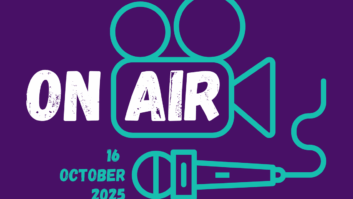If there is one strong theme coming out of the broadcast and media industry at the moment, it is to improve productivity. Studios, equipment hire companies, broadcast and streaming facilities all need to be working at maximum capacity. As an industry, we talk a lot about developing ways for creative and operational staff to enhance efficiency in their workflows, but it is easy to overlook a critical pinch point in the process.
However seamless their workflows, they all depend, at every stage of the chain, on the right underlying technology being available and working properly. A lot of that technology continues to rely on hardware.
Real-world combinations of hardware can be complicated. As an example, the simple “camera”. Which in practice is an end-to-end “camera chain” comprising specific items from multiple vendors: body, mounting plate, pan and tilt head, tripod or pedestal, lens, zoom and focus controls, and viewfinder. These, in turn, rely on a forward connection (fibre, triax, wireless), recording media for camcorders, batteries, CCUs, graded monitors, associated microphones and so on.
How to know the real-time working status of every element? What is the utilisation: is it ready to go? Does it need upgrading, and how long does it need to be booked out of service for this to happen? Has it been fully amortized? When will it go end of life and do you need to plan for servicing or replacement?
The traditional way is to have a spreadsheet asset register and use the busy engineering team to try and keep track of equipment status. This is not practical at scale, especially when utilisation is pushed up, equipment is failing in service, capital budgets are tightening, and the equipment roster becomes more diversified.
Could there be a better solution that more easily tracks multiple suppliers’ equipment and options with all the related documentation about it? Like a MAM but instead to provide end to end technology lifecycle management. What have we learned from MAM solutions and what new technologies could we use to better manage today’s technology estate?
It will know if assets can be individually and accurately identified – through talking to manufacturer or developer databases – if there are hardware or software upgrades available. It will know if the model is out of support and therefore a potential risk. It will give precise metrics for utilisation, and will therefore know when capital investment must be planned. It will also develop an understanding of which assets have more than average downtime and will decide if it is a rogue individual or a greater problem with the design of that piece of equipment.
You will have spotted the major challenge here: creating the asset catalogue in the first place. If only limited data exists (and probably in inconsistent form), how do you generate a comprehensive, accurate catalogue to build on?
Artificial intelligence helps provide the solution. At Beam we have used large language models such as GPT or MosaicML to read existing data, which then conducts automated web searches – on every manufacturer’s support site, and if necessary from other sources – to automatically pull together as much information as possible.
This is not a simple matter. Anyone who has bought broadcast equipment from any of the major manufacturers will know that something seemingly simple involves a number of components, each described by a long and apparently meaningless product number – so long that even if you have some sort of computerised register, the number may already have been truncated to fit.
To date, Beam tracks and organises data on 500,000 different products, including options, in current use in the media industry. We have created a very large knowledge base to draw on, and each time we take on a new user, we inevitably find new products we need to discover. This would have been impossible without a large language model and having the specialist knowledge about how to research and interpret the results.
We have discovered that with this level of asset intelligence – through talking to manufacturer or developer databases – can also automatically notify when there are hardware or software upgrades available. The business can know if the model is out of support and therefore a potential risk. It will give a precise metric for utilisation and will therefore know when additional capital investment must be planned. It will also develop an understanding of which assets have more than average downtime, and will decide if it is a rogue individual or a greater problem with the design of that piece of equipment
With this asset intelligence and a data platform approach, our customers’ engineers and operational managers and the CFO can for the first time work with a common enterprise view of their technology estate across all their sites and facilities. Each can draw their own strategic insights, keeping the facilities running and having actionable data for forward planning.







